A Comparative Analysis: Domain-Specific and Expertise Face Perception
VerifiedAdded on 2023/06/15
|11
|2838
|273
Essay
AI Summary
This essay provides a comparative analysis of the domain-specific and expertise perspectives on face perception, a critical skill for social interaction. The domain-specific viewpoint emphasizes that face perception is an innate ability, honed from infancy, allowing individuals to quickly discern identity, emotion, and gaze. It highlights the neural specialization involved in processing faces and their various attributes. Conversely, the expertise perspective suggests that face perception is a learned skill, requiring years of development and experience to master. While challenging the notion that face individuation is a slow process, it acknowledges the importance of holistic coding of facial features. The essay concludes by summarizing the key aspects of both perspectives and their implications for understanding how humans perceive and interpret faces.
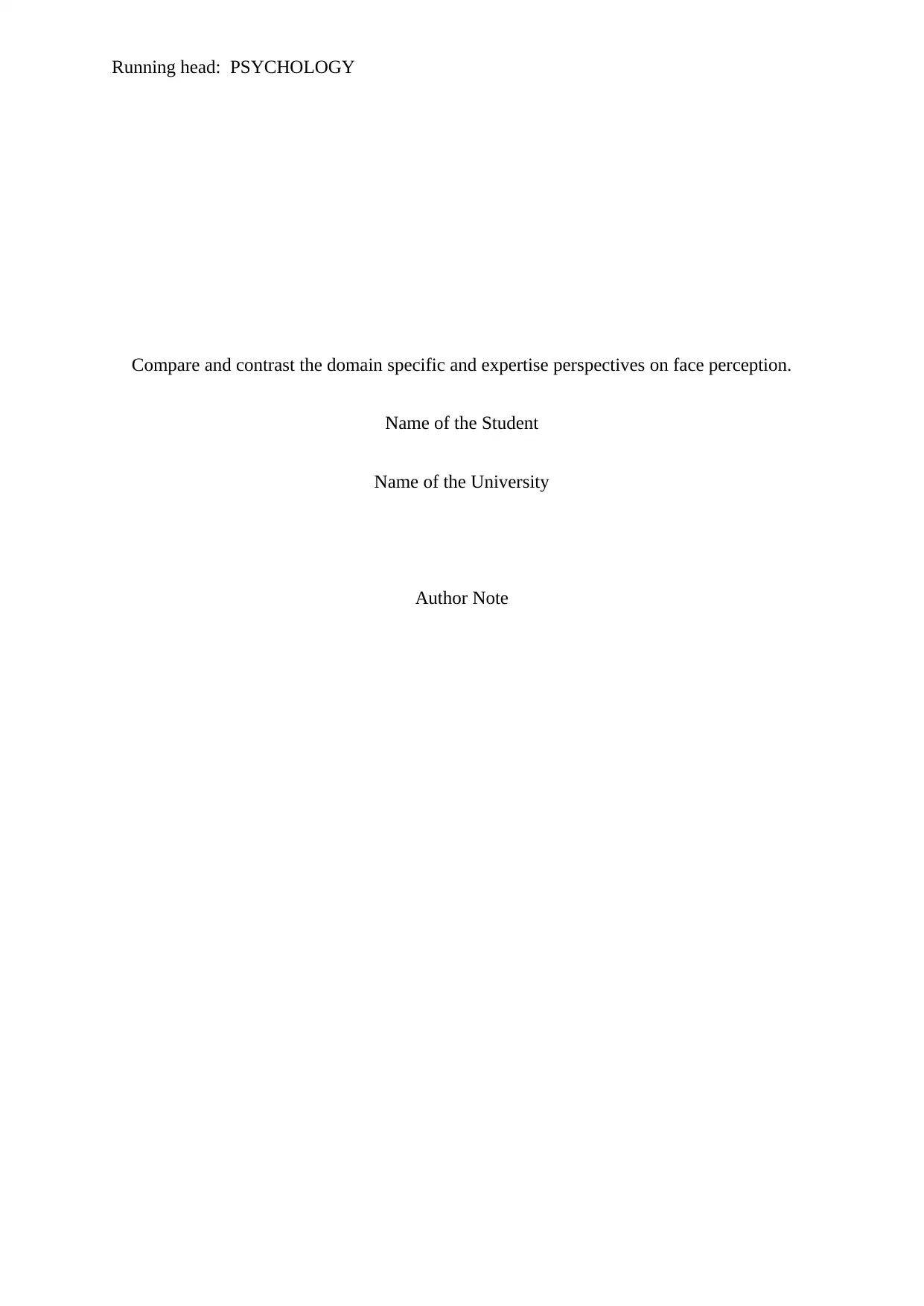
Running head: PSYCHOLOGY
Compare and contrast the domain specific and expertise perspectives on face perception.
Name of the Student
Name of the University
Author Note
Compare and contrast the domain specific and expertise perspectives on face perception.
Name of the Student
Name of the University
Author Note
Paraphrase This Document
Need a fresh take? Get an instant paraphrase of this document with our AI Paraphraser
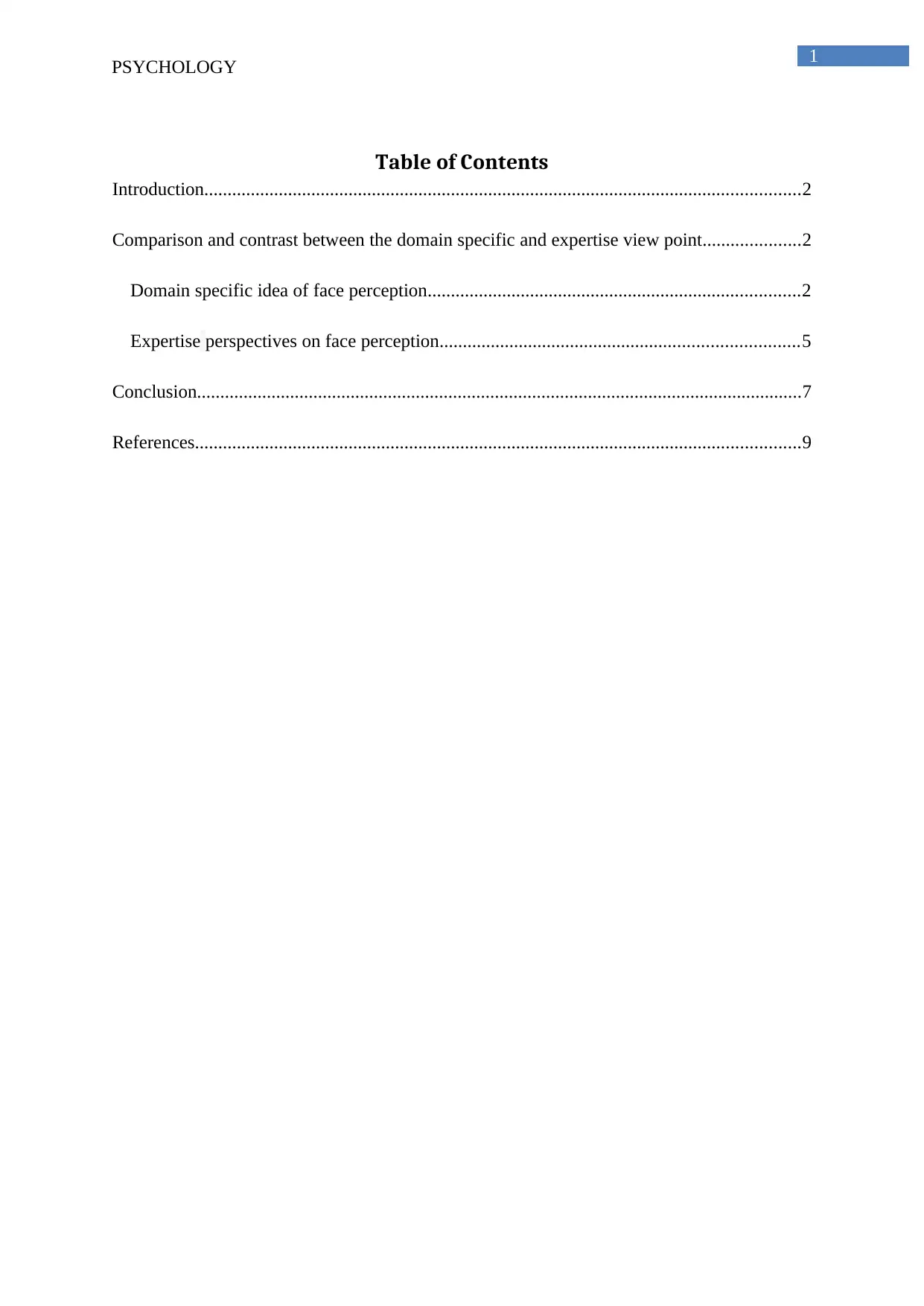
1
PSYCHOLOGY
Table of Contents
Introduction................................................................................................................................2
Comparison and contrast between the domain specific and expertise view point.....................2
Domain specific idea of face perception................................................................................2
Expertise perspectives on face perception.............................................................................5
Conclusion..................................................................................................................................7
References..................................................................................................................................9
PSYCHOLOGY
Table of Contents
Introduction................................................................................................................................2
Comparison and contrast between the domain specific and expertise view point.....................2
Domain specific idea of face perception................................................................................2
Expertise perspectives on face perception.............................................................................5
Conclusion..................................................................................................................................7
References..................................................................................................................................9
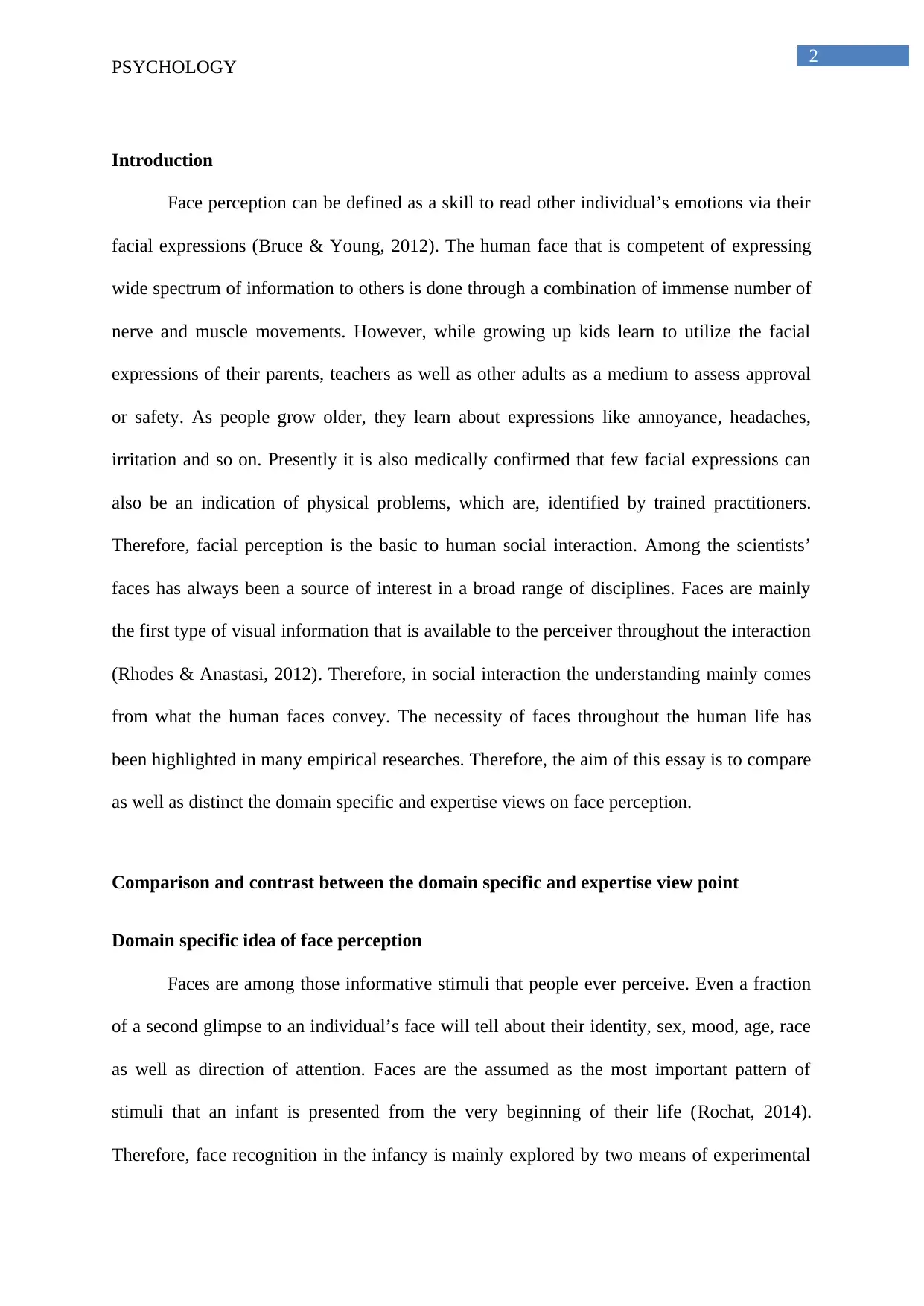
2
PSYCHOLOGY
Introduction
Face perception can be defined as a skill to read other individual’s emotions via their
facial expressions (Bruce & Young, 2012). The human face that is competent of expressing
wide spectrum of information to others is done through a combination of immense number of
nerve and muscle movements. However, while growing up kids learn to utilize the facial
expressions of their parents, teachers as well as other adults as a medium to assess approval
or safety. As people grow older, they learn about expressions like annoyance, headaches,
irritation and so on. Presently it is also medically confirmed that few facial expressions can
also be an indication of physical problems, which are, identified by trained practitioners.
Therefore, facial perception is the basic to human social interaction. Among the scientists’
faces has always been a source of interest in a broad range of disciplines. Faces are mainly
the first type of visual information that is available to the perceiver throughout the interaction
(Rhodes & Anastasi, 2012). Therefore, in social interaction the understanding mainly comes
from what the human faces convey. The necessity of faces throughout the human life has
been highlighted in many empirical researches. Therefore, the aim of this essay is to compare
as well as distinct the domain specific and expertise views on face perception.
Comparison and contrast between the domain specific and expertise view point
Domain specific idea of face perception
Faces are among those informative stimuli that people ever perceive. Even a fraction
of a second glimpse to an individual’s face will tell about their identity, sex, mood, age, race
as well as direction of attention. Faces are the assumed as the most important pattern of
stimuli that an infant is presented from the very beginning of their life (Rochat, 2014).
Therefore, face recognition in the infancy is mainly explored by two means of experimental
PSYCHOLOGY
Introduction
Face perception can be defined as a skill to read other individual’s emotions via their
facial expressions (Bruce & Young, 2012). The human face that is competent of expressing
wide spectrum of information to others is done through a combination of immense number of
nerve and muscle movements. However, while growing up kids learn to utilize the facial
expressions of their parents, teachers as well as other adults as a medium to assess approval
or safety. As people grow older, they learn about expressions like annoyance, headaches,
irritation and so on. Presently it is also medically confirmed that few facial expressions can
also be an indication of physical problems, which are, identified by trained practitioners.
Therefore, facial perception is the basic to human social interaction. Among the scientists’
faces has always been a source of interest in a broad range of disciplines. Faces are mainly
the first type of visual information that is available to the perceiver throughout the interaction
(Rhodes & Anastasi, 2012). Therefore, in social interaction the understanding mainly comes
from what the human faces convey. The necessity of faces throughout the human life has
been highlighted in many empirical researches. Therefore, the aim of this essay is to compare
as well as distinct the domain specific and expertise views on face perception.
Comparison and contrast between the domain specific and expertise view point
Domain specific idea of face perception
Faces are among those informative stimuli that people ever perceive. Even a fraction
of a second glimpse to an individual’s face will tell about their identity, sex, mood, age, race
as well as direction of attention. Faces are the assumed as the most important pattern of
stimuli that an infant is presented from the very beginning of their life (Rochat, 2014).
Therefore, face recognition in the infancy is mainly explored by two means of experimental
⊘ This is a preview!⊘
Do you want full access?
Subscribe today to unlock all pages.

Trusted by 1+ million students worldwide
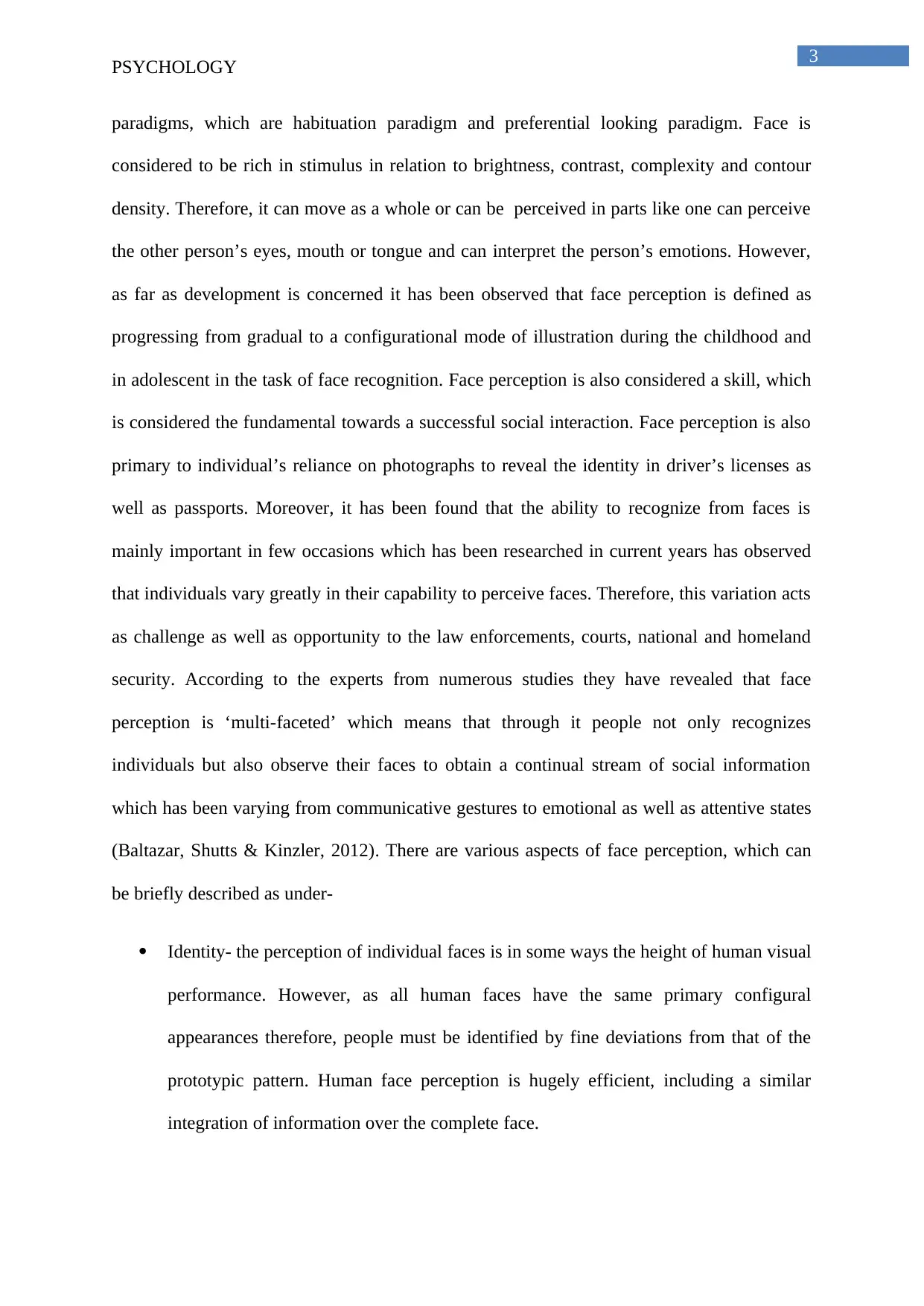
3
PSYCHOLOGY
paradigms, which are habituation paradigm and preferential looking paradigm. Face is
considered to be rich in stimulus in relation to brightness, contrast, complexity and contour
density. Therefore, it can move as a whole or can be perceived in parts like one can perceive
the other person’s eyes, mouth or tongue and can interpret the person’s emotions. However,
as far as development is concerned it has been observed that face perception is defined as
progressing from gradual to a configurational mode of illustration during the childhood and
in adolescent in the task of face recognition. Face perception is also considered a skill, which
is considered the fundamental towards a successful social interaction. Face perception is also
primary to individual’s reliance on photographs to reveal the identity in driver’s licenses as
well as passports. Moreover, it has been found that the ability to recognize from faces is
mainly important in few occasions which has been researched in current years has observed
that individuals vary greatly in their capability to perceive faces. Therefore, this variation acts
as challenge as well as opportunity to the law enforcements, courts, national and homeland
security. According to the experts from numerous studies they have revealed that face
perception is ‘multi-faceted’ which means that through it people not only recognizes
individuals but also observe their faces to obtain a continual stream of social information
which has been varying from communicative gestures to emotional as well as attentive states
(Baltazar, Shutts & Kinzler, 2012). There are various aspects of face perception, which can
be briefly described as under-
Identity- the perception of individual faces is in some ways the height of human visual
performance. However, as all human faces have the same primary configural
appearances therefore, people must be identified by fine deviations from that of the
prototypic pattern. Human face perception is hugely efficient, including a similar
integration of information over the complete face.
PSYCHOLOGY
paradigms, which are habituation paradigm and preferential looking paradigm. Face is
considered to be rich in stimulus in relation to brightness, contrast, complexity and contour
density. Therefore, it can move as a whole or can be perceived in parts like one can perceive
the other person’s eyes, mouth or tongue and can interpret the person’s emotions. However,
as far as development is concerned it has been observed that face perception is defined as
progressing from gradual to a configurational mode of illustration during the childhood and
in adolescent in the task of face recognition. Face perception is also considered a skill, which
is considered the fundamental towards a successful social interaction. Face perception is also
primary to individual’s reliance on photographs to reveal the identity in driver’s licenses as
well as passports. Moreover, it has been found that the ability to recognize from faces is
mainly important in few occasions which has been researched in current years has observed
that individuals vary greatly in their capability to perceive faces. Therefore, this variation acts
as challenge as well as opportunity to the law enforcements, courts, national and homeland
security. According to the experts from numerous studies they have revealed that face
perception is ‘multi-faceted’ which means that through it people not only recognizes
individuals but also observe their faces to obtain a continual stream of social information
which has been varying from communicative gestures to emotional as well as attentive states
(Baltazar, Shutts & Kinzler, 2012). There are various aspects of face perception, which can
be briefly described as under-
Identity- the perception of individual faces is in some ways the height of human visual
performance. However, as all human faces have the same primary configural
appearances therefore, people must be identified by fine deviations from that of the
prototypic pattern. Human face perception is hugely efficient, including a similar
integration of information over the complete face.
Paraphrase This Document
Need a fresh take? Get an instant paraphrase of this document with our AI Paraphraser
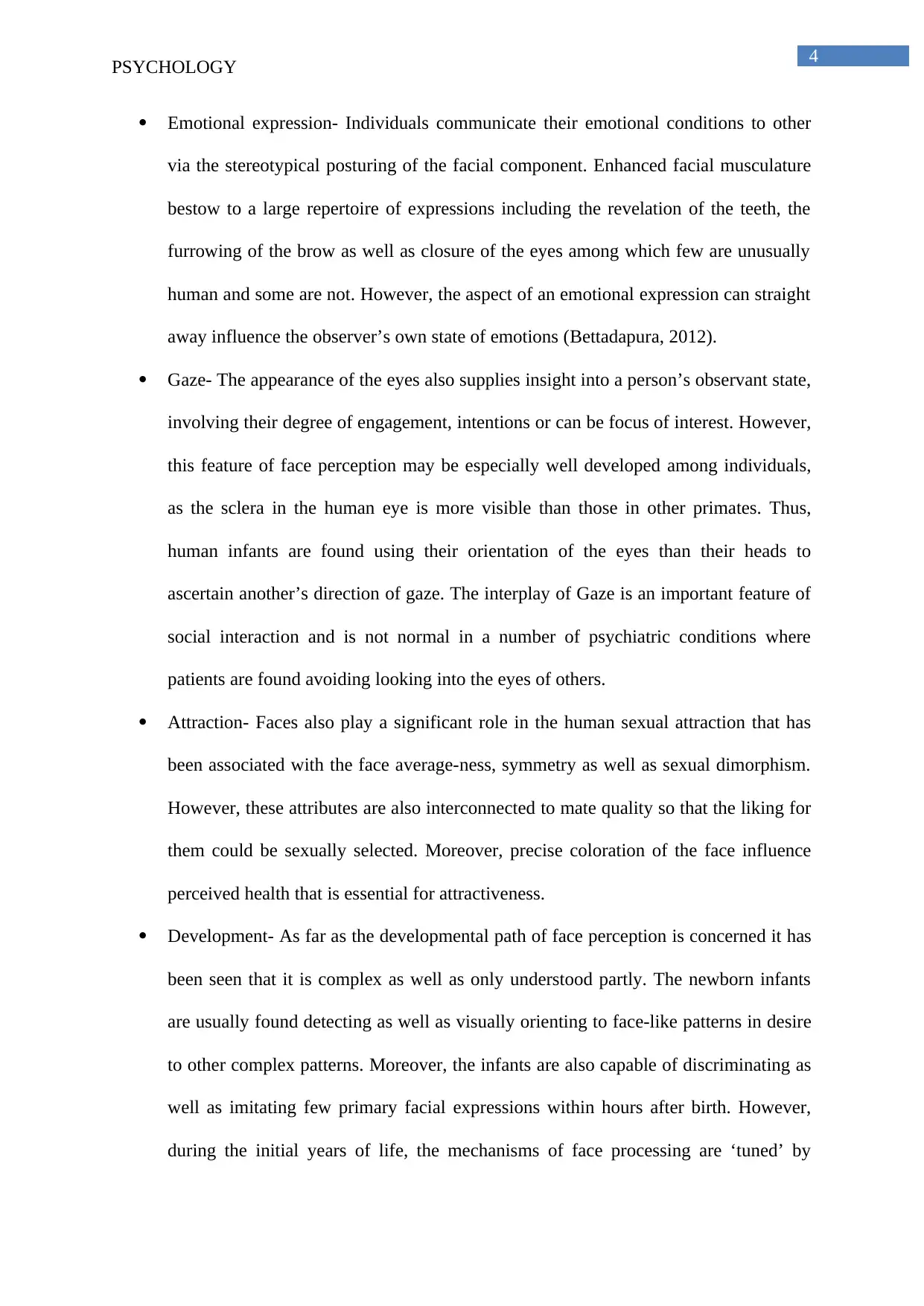
4
PSYCHOLOGY
Emotional expression- Individuals communicate their emotional conditions to other
via the stereotypical posturing of the facial component. Enhanced facial musculature
bestow to a large repertoire of expressions including the revelation of the teeth, the
furrowing of the brow as well as closure of the eyes among which few are unusually
human and some are not. However, the aspect of an emotional expression can straight
away influence the observer’s own state of emotions (Bettadapura, 2012).
Gaze- The appearance of the eyes also supplies insight into a person’s observant state,
involving their degree of engagement, intentions or can be focus of interest. However,
this feature of face perception may be especially well developed among individuals,
as the sclera in the human eye is more visible than those in other primates. Thus,
human infants are found using their orientation of the eyes than their heads to
ascertain another’s direction of gaze. The interplay of Gaze is an important feature of
social interaction and is not normal in a number of psychiatric conditions where
patients are found avoiding looking into the eyes of others.
Attraction- Faces also play a significant role in the human sexual attraction that has
been associated with the face average-ness, symmetry as well as sexual dimorphism.
However, these attributes are also interconnected to mate quality so that the liking for
them could be sexually selected. Moreover, precise coloration of the face influence
perceived health that is essential for attractiveness.
Development- As far as the developmental path of face perception is concerned it has
been seen that it is complex as well as only understood partly. The newborn infants
are usually found detecting as well as visually orienting to face-like patterns in desire
to other complex patterns. Moreover, the infants are also capable of discriminating as
well as imitating few primary facial expressions within hours after birth. However,
during the initial years of life, the mechanisms of face processing are ‘tuned’ by
PSYCHOLOGY
Emotional expression- Individuals communicate their emotional conditions to other
via the stereotypical posturing of the facial component. Enhanced facial musculature
bestow to a large repertoire of expressions including the revelation of the teeth, the
furrowing of the brow as well as closure of the eyes among which few are unusually
human and some are not. However, the aspect of an emotional expression can straight
away influence the observer’s own state of emotions (Bettadapura, 2012).
Gaze- The appearance of the eyes also supplies insight into a person’s observant state,
involving their degree of engagement, intentions or can be focus of interest. However,
this feature of face perception may be especially well developed among individuals,
as the sclera in the human eye is more visible than those in other primates. Thus,
human infants are found using their orientation of the eyes than their heads to
ascertain another’s direction of gaze. The interplay of Gaze is an important feature of
social interaction and is not normal in a number of psychiatric conditions where
patients are found avoiding looking into the eyes of others.
Attraction- Faces also play a significant role in the human sexual attraction that has
been associated with the face average-ness, symmetry as well as sexual dimorphism.
However, these attributes are also interconnected to mate quality so that the liking for
them could be sexually selected. Moreover, precise coloration of the face influence
perceived health that is essential for attractiveness.
Development- As far as the developmental path of face perception is concerned it has
been seen that it is complex as well as only understood partly. The newborn infants
are usually found detecting as well as visually orienting to face-like patterns in desire
to other complex patterns. Moreover, the infants are also capable of discriminating as
well as imitating few primary facial expressions within hours after birth. However,
during the initial years of life, the mechanisms of face processing are ‘tuned’ by
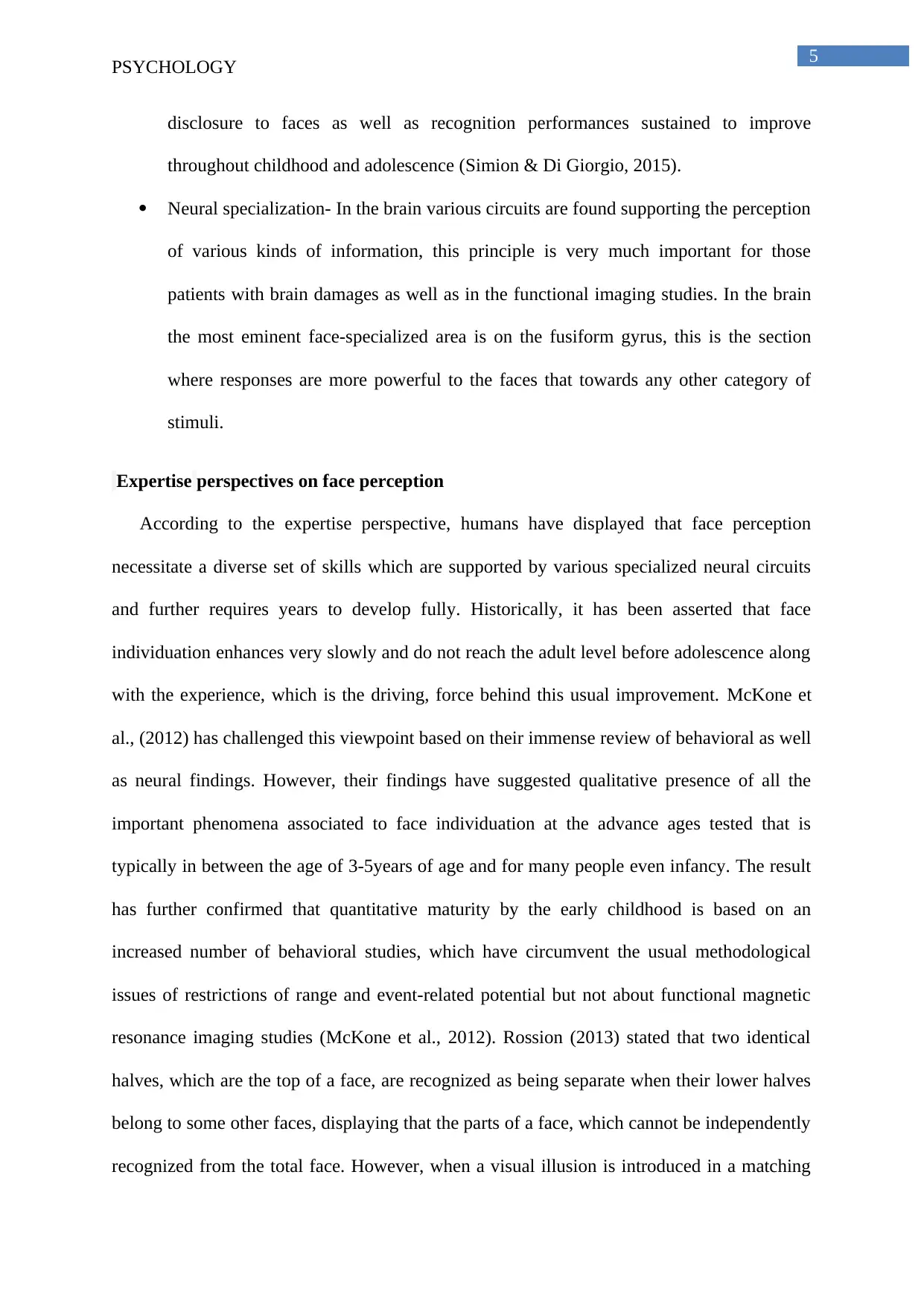
5
PSYCHOLOGY
disclosure to faces as well as recognition performances sustained to improve
throughout childhood and adolescence (Simion & Di Giorgio, 2015).
Neural specialization- In the brain various circuits are found supporting the perception
of various kinds of information, this principle is very much important for those
patients with brain damages as well as in the functional imaging studies. In the brain
the most eminent face-specialized area is on the fusiform gyrus, this is the section
where responses are more powerful to the faces that towards any other category of
stimuli.
Expertise perspectives on face perception
According to the expertise perspective, humans have displayed that face perception
necessitate a diverse set of skills which are supported by various specialized neural circuits
and further requires years to develop fully. Historically, it has been asserted that face
individuation enhances very slowly and do not reach the adult level before adolescence along
with the experience, which is the driving, force behind this usual improvement. McKone et
al., (2012) has challenged this viewpoint based on their immense review of behavioral as well
as neural findings. However, their findings have suggested qualitative presence of all the
important phenomena associated to face individuation at the advance ages tested that is
typically in between the age of 3-5years of age and for many people even infancy. The result
has further confirmed that quantitative maturity by the early childhood is based on an
increased number of behavioral studies, which have circumvent the usual methodological
issues of restrictions of range and event-related potential but not about functional magnetic
resonance imaging studies (McKone et al., 2012). Rossion (2013) stated that two identical
halves, which are the top of a face, are recognized as being separate when their lower halves
belong to some other faces, displaying that the parts of a face, which cannot be independently
recognized from the total face. However, when a visual illusion is introduced in a matching
PSYCHOLOGY
disclosure to faces as well as recognition performances sustained to improve
throughout childhood and adolescence (Simion & Di Giorgio, 2015).
Neural specialization- In the brain various circuits are found supporting the perception
of various kinds of information, this principle is very much important for those
patients with brain damages as well as in the functional imaging studies. In the brain
the most eminent face-specialized area is on the fusiform gyrus, this is the section
where responses are more powerful to the faces that towards any other category of
stimuli.
Expertise perspectives on face perception
According to the expertise perspective, humans have displayed that face perception
necessitate a diverse set of skills which are supported by various specialized neural circuits
and further requires years to develop fully. Historically, it has been asserted that face
individuation enhances very slowly and do not reach the adult level before adolescence along
with the experience, which is the driving, force behind this usual improvement. McKone et
al., (2012) has challenged this viewpoint based on their immense review of behavioral as well
as neural findings. However, their findings have suggested qualitative presence of all the
important phenomena associated to face individuation at the advance ages tested that is
typically in between the age of 3-5years of age and for many people even infancy. The result
has further confirmed that quantitative maturity by the early childhood is based on an
increased number of behavioral studies, which have circumvent the usual methodological
issues of restrictions of range and event-related potential but not about functional magnetic
resonance imaging studies (McKone et al., 2012). Rossion (2013) stated that two identical
halves, which are the top of a face, are recognized as being separate when their lower halves
belong to some other faces, displaying that the parts of a face, which cannot be independently
recognized from the total face. However, when a visual illusion is introduced in a matching
⊘ This is a preview!⊘
Do you want full access?
Subscribe today to unlock all pages.

Trusted by 1+ million students worldwide
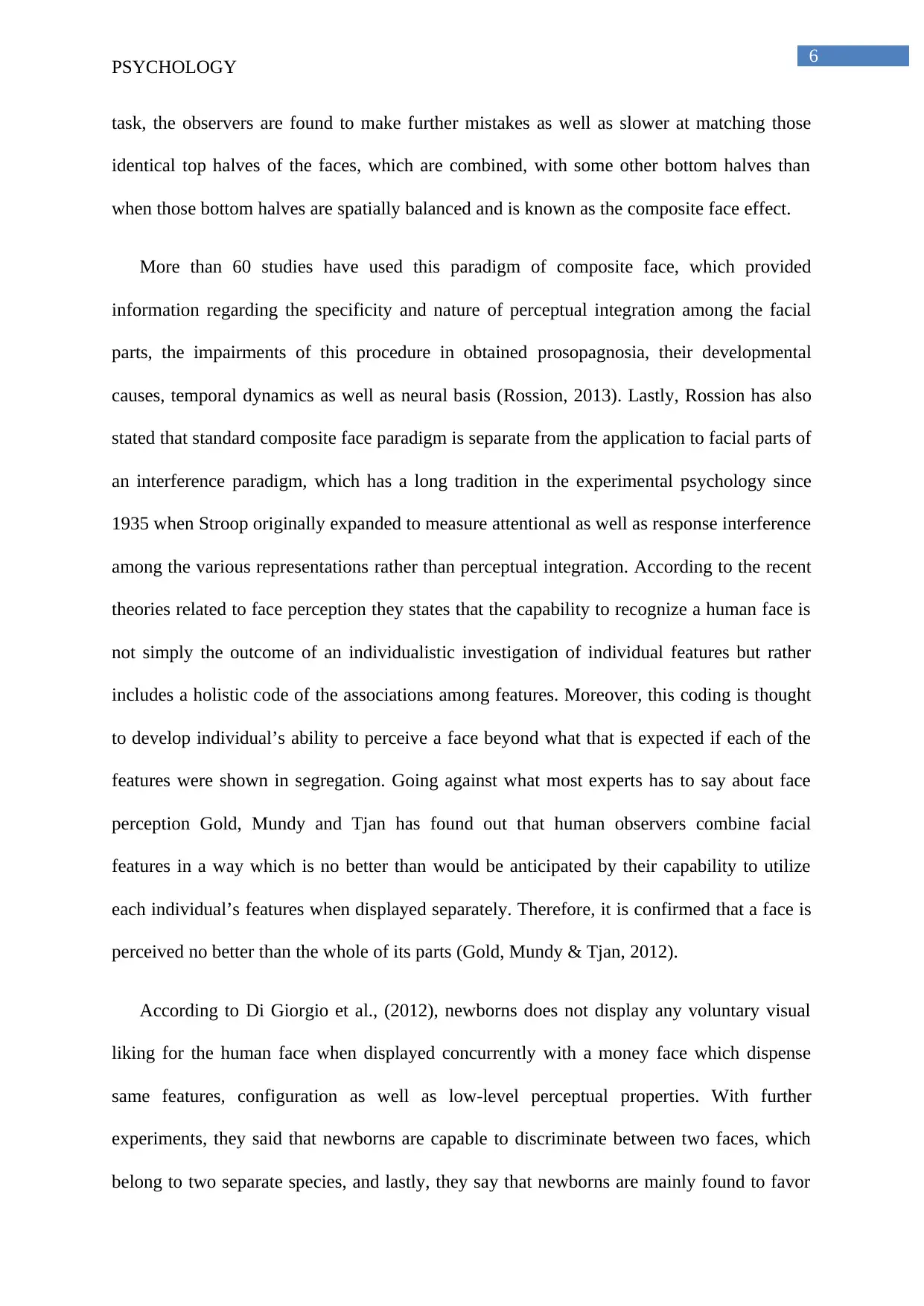
6
PSYCHOLOGY
task, the observers are found to make further mistakes as well as slower at matching those
identical top halves of the faces, which are combined, with some other bottom halves than
when those bottom halves are spatially balanced and is known as the composite face effect.
More than 60 studies have used this paradigm of composite face, which provided
information regarding the specificity and nature of perceptual integration among the facial
parts, the impairments of this procedure in obtained prosopagnosia, their developmental
causes, temporal dynamics as well as neural basis (Rossion, 2013). Lastly, Rossion has also
stated that standard composite face paradigm is separate from the application to facial parts of
an interference paradigm, which has a long tradition in the experimental psychology since
1935 when Stroop originally expanded to measure attentional as well as response interference
among the various representations rather than perceptual integration. According to the recent
theories related to face perception they states that the capability to recognize a human face is
not simply the outcome of an individualistic investigation of individual features but rather
includes a holistic code of the associations among features. Moreover, this coding is thought
to develop individual’s ability to perceive a face beyond what that is expected if each of the
features were shown in segregation. Going against what most experts has to say about face
perception Gold, Mundy and Tjan has found out that human observers combine facial
features in a way which is no better than would be anticipated by their capability to utilize
each individual’s features when displayed separately. Therefore, it is confirmed that a face is
perceived no better than the whole of its parts (Gold, Mundy & Tjan, 2012).
According to Di Giorgio et al., (2012), newborns does not display any voluntary visual
liking for the human face when displayed concurrently with a money face which dispense
same features, configuration as well as low-level perceptual properties. With further
experiments, they said that newborns are capable to discriminate between two faces, which
belong to two separate species, and lastly, they say that newborns are mainly found to favor
PSYCHOLOGY
task, the observers are found to make further mistakes as well as slower at matching those
identical top halves of the faces, which are combined, with some other bottom halves than
when those bottom halves are spatially balanced and is known as the composite face effect.
More than 60 studies have used this paradigm of composite face, which provided
information regarding the specificity and nature of perceptual integration among the facial
parts, the impairments of this procedure in obtained prosopagnosia, their developmental
causes, temporal dynamics as well as neural basis (Rossion, 2013). Lastly, Rossion has also
stated that standard composite face paradigm is separate from the application to facial parts of
an interference paradigm, which has a long tradition in the experimental psychology since
1935 when Stroop originally expanded to measure attentional as well as response interference
among the various representations rather than perceptual integration. According to the recent
theories related to face perception they states that the capability to recognize a human face is
not simply the outcome of an individualistic investigation of individual features but rather
includes a holistic code of the associations among features. Moreover, this coding is thought
to develop individual’s ability to perceive a face beyond what that is expected if each of the
features were shown in segregation. Going against what most experts has to say about face
perception Gold, Mundy and Tjan has found out that human observers combine facial
features in a way which is no better than would be anticipated by their capability to utilize
each individual’s features when displayed separately. Therefore, it is confirmed that a face is
perceived no better than the whole of its parts (Gold, Mundy & Tjan, 2012).
According to Di Giorgio et al., (2012), newborns does not display any voluntary visual
liking for the human face when displayed concurrently with a money face which dispense
same features, configuration as well as low-level perceptual properties. With further
experiments, they said that newborns are capable to discriminate between two faces, which
belong to two separate species, and lastly, they say that newborns are mainly found to favor
Paraphrase This Document
Need a fresh take? Get an instant paraphrase of this document with our AI Paraphraser
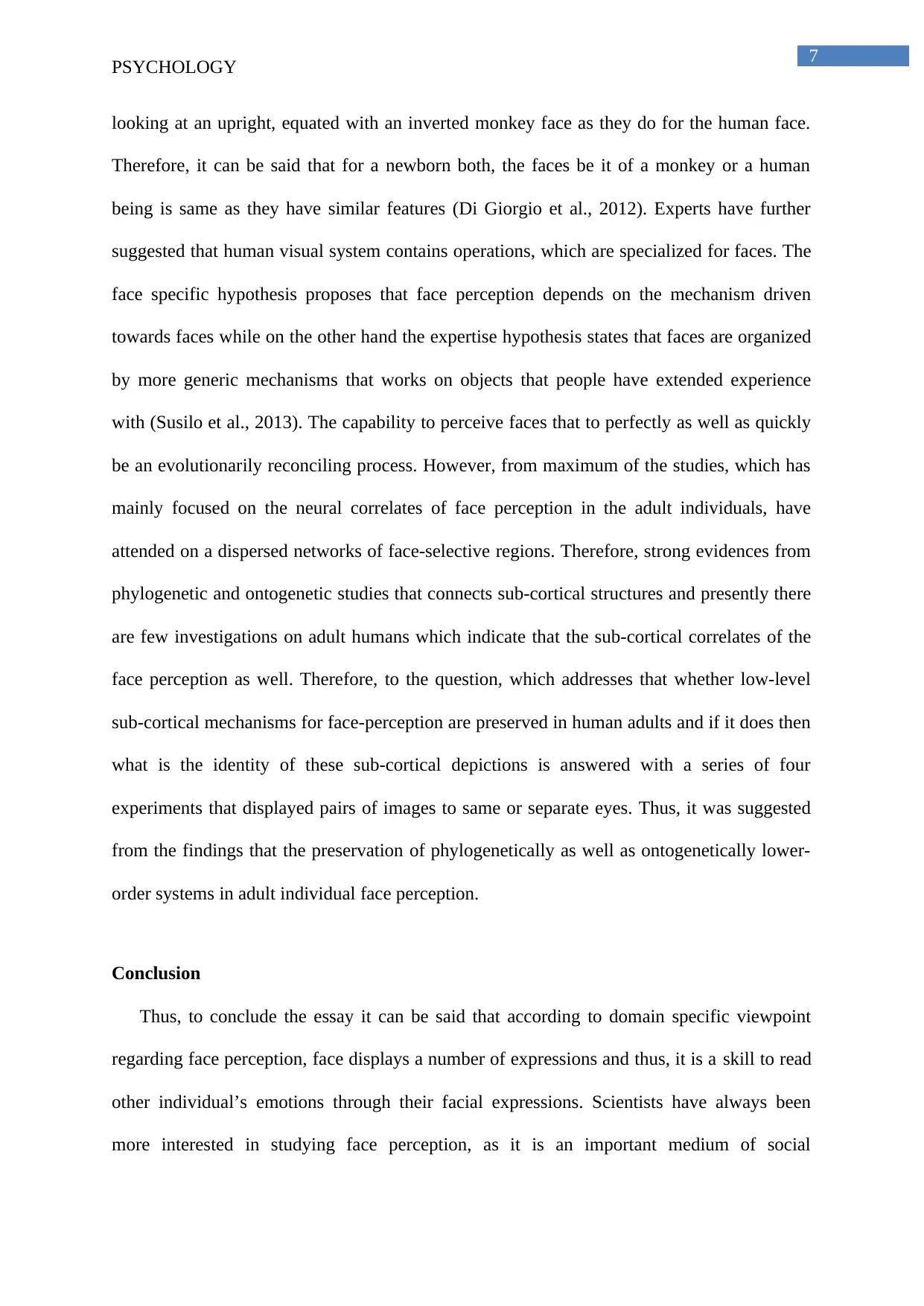
7
PSYCHOLOGY
looking at an upright, equated with an inverted monkey face as they do for the human face.
Therefore, it can be said that for a newborn both, the faces be it of a monkey or a human
being is same as they have similar features (Di Giorgio et al., 2012). Experts have further
suggested that human visual system contains operations, which are specialized for faces. The
face specific hypothesis proposes that face perception depends on the mechanism driven
towards faces while on the other hand the expertise hypothesis states that faces are organized
by more generic mechanisms that works on objects that people have extended experience
with (Susilo et al., 2013). The capability to perceive faces that to perfectly as well as quickly
be an evolutionarily reconciling process. However, from maximum of the studies, which has
mainly focused on the neural correlates of face perception in the adult individuals, have
attended on a dispersed networks of face-selective regions. Therefore, strong evidences from
phylogenetic and ontogenetic studies that connects sub-cortical structures and presently there
are few investigations on adult humans which indicate that the sub-cortical correlates of the
face perception as well. Therefore, to the question, which addresses that whether low-level
sub-cortical mechanisms for face-perception are preserved in human adults and if it does then
what is the identity of these sub-cortical depictions is answered with a series of four
experiments that displayed pairs of images to same or separate eyes. Thus, it was suggested
from the findings that the preservation of phylogenetically as well as ontogenetically lower-
order systems in adult individual face perception.
Conclusion
Thus, to conclude the essay it can be said that according to domain specific viewpoint
regarding face perception, face displays a number of expressions and thus, it is a skill to read
other individual’s emotions through their facial expressions. Scientists have always been
more interested in studying face perception, as it is an important medium of social
PSYCHOLOGY
looking at an upright, equated with an inverted monkey face as they do for the human face.
Therefore, it can be said that for a newborn both, the faces be it of a monkey or a human
being is same as they have similar features (Di Giorgio et al., 2012). Experts have further
suggested that human visual system contains operations, which are specialized for faces. The
face specific hypothesis proposes that face perception depends on the mechanism driven
towards faces while on the other hand the expertise hypothesis states that faces are organized
by more generic mechanisms that works on objects that people have extended experience
with (Susilo et al., 2013). The capability to perceive faces that to perfectly as well as quickly
be an evolutionarily reconciling process. However, from maximum of the studies, which has
mainly focused on the neural correlates of face perception in the adult individuals, have
attended on a dispersed networks of face-selective regions. Therefore, strong evidences from
phylogenetic and ontogenetic studies that connects sub-cortical structures and presently there
are few investigations on adult humans which indicate that the sub-cortical correlates of the
face perception as well. Therefore, to the question, which addresses that whether low-level
sub-cortical mechanisms for face-perception are preserved in human adults and if it does then
what is the identity of these sub-cortical depictions is answered with a series of four
experiments that displayed pairs of images to same or separate eyes. Thus, it was suggested
from the findings that the preservation of phylogenetically as well as ontogenetically lower-
order systems in adult individual face perception.
Conclusion
Thus, to conclude the essay it can be said that according to domain specific viewpoint
regarding face perception, face displays a number of expressions and thus, it is a skill to read
other individual’s emotions through their facial expressions. Scientists have always been
more interested in studying face perception, as it is an important medium of social
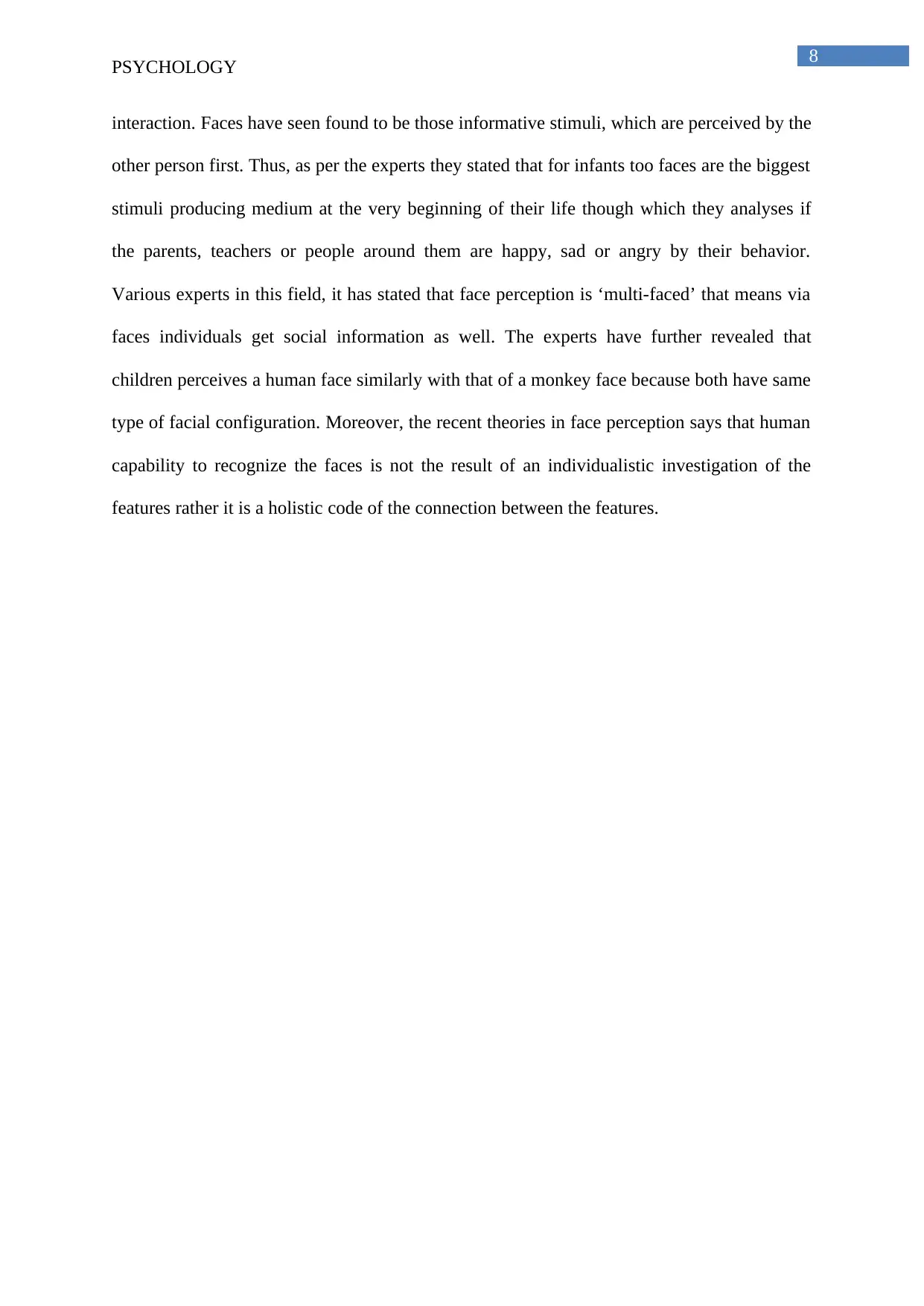
8
PSYCHOLOGY
interaction. Faces have seen found to be those informative stimuli, which are perceived by the
other person first. Thus, as per the experts they stated that for infants too faces are the biggest
stimuli producing medium at the very beginning of their life though which they analyses if
the parents, teachers or people around them are happy, sad or angry by their behavior.
Various experts in this field, it has stated that face perception is ‘multi-faced’ that means via
faces individuals get social information as well. The experts have further revealed that
children perceives a human face similarly with that of a monkey face because both have same
type of facial configuration. Moreover, the recent theories in face perception says that human
capability to recognize the faces is not the result of an individualistic investigation of the
features rather it is a holistic code of the connection between the features.
PSYCHOLOGY
interaction. Faces have seen found to be those informative stimuli, which are perceived by the
other person first. Thus, as per the experts they stated that for infants too faces are the biggest
stimuli producing medium at the very beginning of their life though which they analyses if
the parents, teachers or people around them are happy, sad or angry by their behavior.
Various experts in this field, it has stated that face perception is ‘multi-faced’ that means via
faces individuals get social information as well. The experts have further revealed that
children perceives a human face similarly with that of a monkey face because both have same
type of facial configuration. Moreover, the recent theories in face perception says that human
capability to recognize the faces is not the result of an individualistic investigation of the
features rather it is a holistic code of the connection between the features.
⊘ This is a preview!⊘
Do you want full access?
Subscribe today to unlock all pages.

Trusted by 1+ million students worldwide
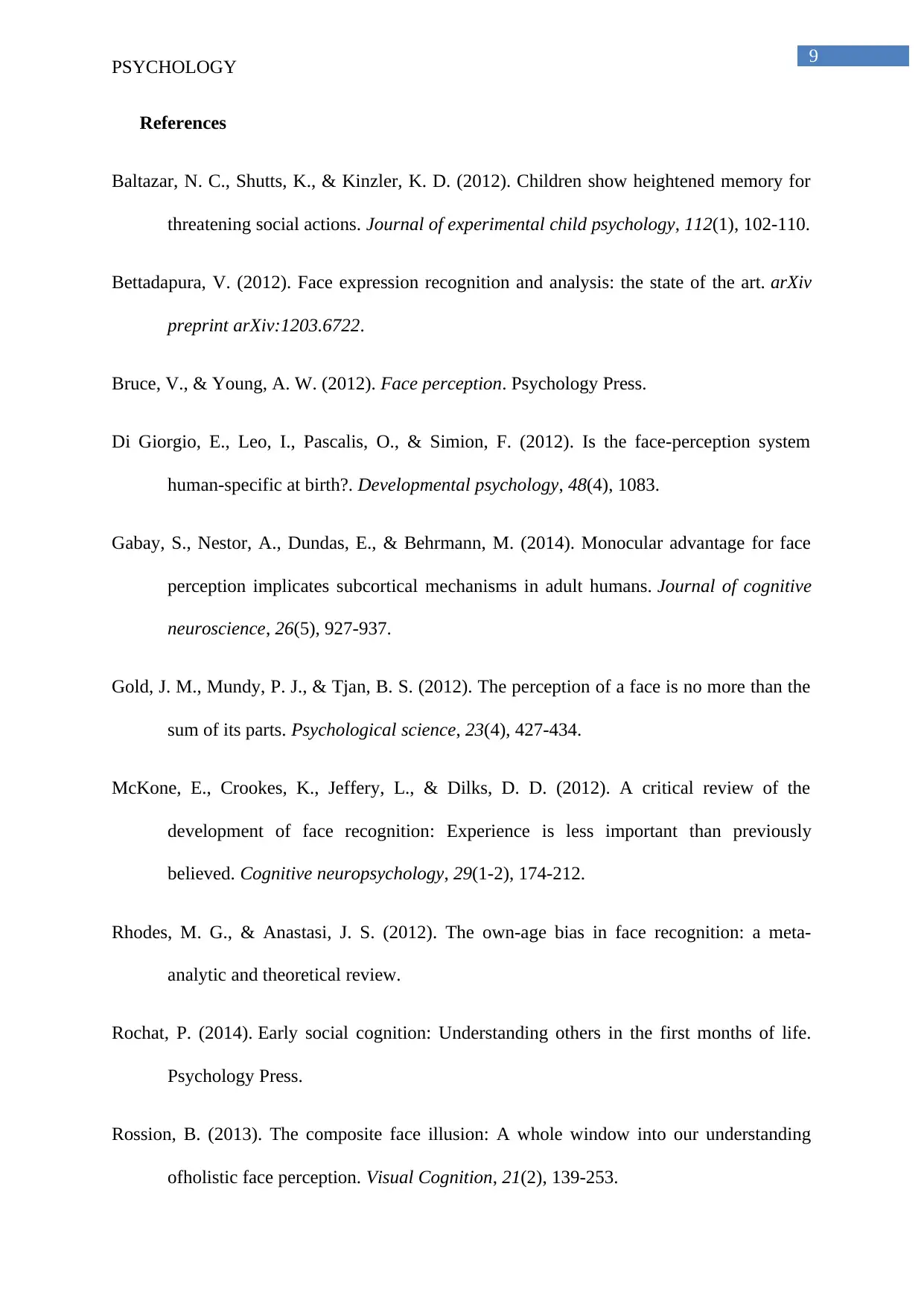
9
PSYCHOLOGY
References
Baltazar, N. C., Shutts, K., & Kinzler, K. D. (2012). Children show heightened memory for
threatening social actions. Journal of experimental child psychology, 112(1), 102-110.
Bettadapura, V. (2012). Face expression recognition and analysis: the state of the art. arXiv
preprint arXiv:1203.6722.
Bruce, V., & Young, A. W. (2012). Face perception. Psychology Press.
Di Giorgio, E., Leo, I., Pascalis, O., & Simion, F. (2012). Is the face-perception system
human-specific at birth?. Developmental psychology, 48(4), 1083.
Gabay, S., Nestor, A., Dundas, E., & Behrmann, M. (2014). Monocular advantage for face
perception implicates subcortical mechanisms in adult humans. Journal of cognitive
neuroscience, 26(5), 927-937.
Gold, J. M., Mundy, P. J., & Tjan, B. S. (2012). The perception of a face is no more than the
sum of its parts. Psychological science, 23(4), 427-434.
McKone, E., Crookes, K., Jeffery, L., & Dilks, D. D. (2012). A critical review of the
development of face recognition: Experience is less important than previously
believed. Cognitive neuropsychology, 29(1-2), 174-212.
Rhodes, M. G., & Anastasi, J. S. (2012). The own-age bias in face recognition: a meta-
analytic and theoretical review.
Rochat, P. (2014). Early social cognition: Understanding others in the first months of life.
Psychology Press.
Rossion, B. (2013). The composite face illusion: A whole window into our understanding
ofholistic face perception. Visual Cognition, 21(2), 139-253.
PSYCHOLOGY
References
Baltazar, N. C., Shutts, K., & Kinzler, K. D. (2012). Children show heightened memory for
threatening social actions. Journal of experimental child psychology, 112(1), 102-110.
Bettadapura, V. (2012). Face expression recognition and analysis: the state of the art. arXiv
preprint arXiv:1203.6722.
Bruce, V., & Young, A. W. (2012). Face perception. Psychology Press.
Di Giorgio, E., Leo, I., Pascalis, O., & Simion, F. (2012). Is the face-perception system
human-specific at birth?. Developmental psychology, 48(4), 1083.
Gabay, S., Nestor, A., Dundas, E., & Behrmann, M. (2014). Monocular advantage for face
perception implicates subcortical mechanisms in adult humans. Journal of cognitive
neuroscience, 26(5), 927-937.
Gold, J. M., Mundy, P. J., & Tjan, B. S. (2012). The perception of a face is no more than the
sum of its parts. Psychological science, 23(4), 427-434.
McKone, E., Crookes, K., Jeffery, L., & Dilks, D. D. (2012). A critical review of the
development of face recognition: Experience is less important than previously
believed. Cognitive neuropsychology, 29(1-2), 174-212.
Rhodes, M. G., & Anastasi, J. S. (2012). The own-age bias in face recognition: a meta-
analytic and theoretical review.
Rochat, P. (2014). Early social cognition: Understanding others in the first months of life.
Psychology Press.
Rossion, B. (2013). The composite face illusion: A whole window into our understanding
ofholistic face perception. Visual Cognition, 21(2), 139-253.
Paraphrase This Document
Need a fresh take? Get an instant paraphrase of this document with our AI Paraphraser

10
PSYCHOLOGY
Simion, F., & Di Giorgio, E. (2015). Face perception and processing in early infancy: inborn
predispositions and developmental changes. Frontiers in psychology, 6.
Susilo, T., Yovel, G., Barton, J. J., & Duchaine, B. (2013). Face perception is category-
specific: Evidence from normal body perception in acquired
prosopagnosia. Cognition, 129(1), 88-94.
PSYCHOLOGY
Simion, F., & Di Giorgio, E. (2015). Face perception and processing in early infancy: inborn
predispositions and developmental changes. Frontiers in psychology, 6.
Susilo, T., Yovel, G., Barton, J. J., & Duchaine, B. (2013). Face perception is category-
specific: Evidence from normal body perception in acquired
prosopagnosia. Cognition, 129(1), 88-94.
1 out of 11
Related Documents
Your All-in-One AI-Powered Toolkit for Academic Success.
+13062052269
info@desklib.com
Available 24*7 on WhatsApp / Email
![[object Object]](/_next/static/media/star-bottom.7253800d.svg)
Unlock your academic potential
Copyright © 2020–2025 A2Z Services. All Rights Reserved. Developed and managed by ZUCOL.




